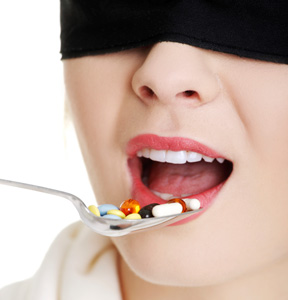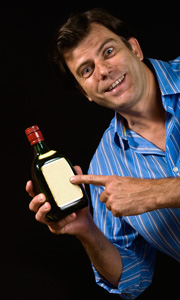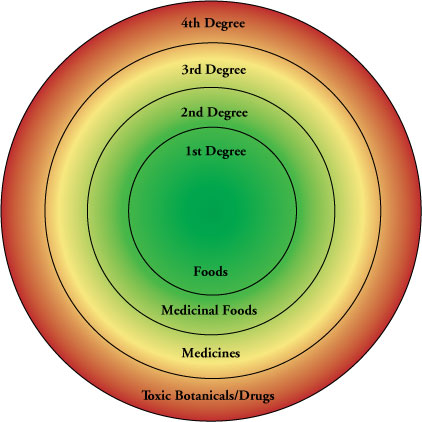Stay Informed
Popular Articles
- Hiatal Hernia: Hidden Cause of Chronic Illness
- Small Intestinal Bacterial Overgrowth (SIBO)
- Applied Lymphology: Unlocking the Secret to Pain Relief
- An Introduction to Constitutional Iridology
- The Low Down on Liver Detoxification
- An Energetic and Emotional Approach to Cancer
- Fat Facts
- Marrow in the Bones
- Blood Type and Nutrition
- Cardiac Herbs: Beyond Hawthorn
Quick Search
The School of Modern Herbal Medicine




War in the Natural Health World
- 8/5/2014
- Categorized in: General Health
 There is a silent war being waged in the natural health world. The battle is between those who are genuinely interested in helping people to improve their health and those who are just pushing products without good science or even a historical tradition of use.
There is a silent war being waged in the natural health world. The battle is between those who are genuinely interested in helping people to improve their health and those who are just pushing products without good science or even a historical tradition of use.
The foremost rule in healing is, “first do no harm.” Unfortunately, deceitful marketing propaganda often convinces innocent people that harmful things are harmless. As a result, people who are trying to heal themselves get hurt and sometimes even die.
For example, let’s take MMS, a solution of 28% sodium chlorite that degrades into chlorine dioxide when administered as directed by Jim Humble, MMS’s foremost proponent. People in the natural world have been concerned for years about the effects of adding chlorine to municipal water supplies. There is some research showing it interferes with iodine absorption and causes thyroid issues, even in the very dilute doses used. Yet proponents of MMS advocate ingesting much higher doses than are found in city water supplies.
The fact is the effects of chlorine dioxide are identical to ingesting bleach, which include nausea, vomiting, even death. Yet Humble has convinced a handful of passionate marketers and alternative practitioners that MMS will cure everything from malaria to cancer, all without a shred of evidence. This is just one of many examples of products that are being marketed by passionate proponents without real historical or scientific evidence to back up their safety or effectiveness. The sad thing about this is that it makes the whole natural health industry look bad in the eyes of reputable scientists and medical professionals as well as informed people in the general public.
So, what do you look for to determine if a product may be safe and effective versus one being marketed on hype? Here are some things to consider:
Step 1. Watch Out for Pseudoscience
Proponents of _________ (insert latest, newest, miracle cure here) will point you towards articles that overwhelm the average consumer with technical jargon. These articles don't provide any sort of reasonable explanation for how the product works. If you actually read the “science” behind it, it usually defies even the most basic understanding of chemistry, physiology, or both.
A common technique used by those who are deceiving people, and copied by those that don’t know better, is to extrapolate internal use from petri dish studies. Chlorine dioxide kills viruses and bacteria in petri dishes, as do many essential oils. This does not mean that the product will kill viruses and bacteria when taken internally, at least not in doses safe for human consumption.
To prove this point all you need to do is look at a substance that does a wonderful job of killing bacteria and viruses in petri dishes—alcohol. If you apply the same logic to alcohol as proponents of MMS and those that advocate the internal use of essential oils do, then getting drunk would kill infectious bacteria and viruses. You see, the body is just not as simple as that.
So, when you see these kinds of claims, you might ask questions like:
- Have there been any in vivo test (test on live animals or humans as opposed to in petri dishes) showing the efficacy of this substance? If not, ask:
- What concentration did it take in the petri dish to kill _____?
- How much do I have to ingest to reach this same concentration in my blood and tissues?
- At what concentration is it toxic when taken internally?
Step 2. Be Cautious with Testimonials
 The people that dare to question the marketing babble for some products are then pointed towards testimonials, most of which are written by the marketers. What’s important here is to understand the difference between clinical research and testimonials. Herbal medicine is filled with clinical research, where numerous herbalists, often over generations, test and refine their understanding of remedies. This research is being done by people whose goal is to help people heal, not just to sell a product.
The people that dare to question the marketing babble for some products are then pointed towards testimonials, most of which are written by the marketers. What’s important here is to understand the difference between clinical research and testimonials. Herbal medicine is filled with clinical research, where numerous herbalists, often over generations, test and refine their understanding of remedies. This research is being done by people whose goal is to help people heal, not just to sell a product.
Most people do not understand how powerful the mind (and therefore the placebo response) is. Every new remedy people put out into the marketplace is going to have someone get better by taking it, even if it’s mercury, dirt, urine, or a sugar pill. This does not mean it will work for everyone, or even a majority of the people who try it. Nor does it mean it’s safe. Just because you didn’t immediately die from ingesting bleach doesn’t mean it won’t have long-term harmful effects, and it doesn’t mean that the next person that tries it won’t die.
So, testimonials can be an effective way to find something helpful, as long as the substance has a long history of safe use in a consistent manner. I prefer empirical evidence from practitioners which I trust over individual’s testimony for the many things that have not been tested by modern science.
Step 3. Watch for the Straw Man Conspiracy
If you’re still unconvinced to take the _____ miracle cure after listening to the poor research and testimonials, you’re doing great! Now, you can sit back and enjoy the show! All that’s left is to endure the death rattles of the unscrupulous or uninformed salesman, because this is where the proponent of the miracle cure goes into full attack mode, creating a new opponent and attacking him viscously. THE SCIENTIFC COMMUNITY IS TO BLAME he rants, blaming the lack of information on a conspiracy to make everyone sick.
Here’s the thing folks, not everything is a conspiracy. While there is a lack of funding for research into many natural things, I don’t believe there is an active conspiracy to suppress information. In fact at no time in history has there been as much research done on herbs and vitamins as today. We still have a long ways to go, but we’re getting there!
It’s sad to say, but there are con artists galore in the natural health world, preying on those that have a natural distrust of the establishment, and those that have found nothing but misery with our modern medical paradigm. I’m going to give you a couple of ways to sort the seed from the chaff, but first, let’s get back to our passionate salesman.
Step 4. Evaluate “Expert” Information
If pseudoscience, testimonials and conspiracies haven’t swayed you yet, you might be off the hook. However the most unscrupulous of people will now turn to intentional deceit. Many times you're directed to videos showing miraculous results where "officials" often times portrayed as doctors, voice their support.
In the case of MMS there is even a "documentary" filmed in Africa showing local doctors using MMS on people and then showing the "results" proving it cures malaria. The film, while well made, has been shown to be a fake. That’s right, they FAKED a film about MMS curing malaria.
The Bottom Line
So, considering all the foregoing information, we’re left with a few questions.
- First, how do you know if an herb/supplement is safe?
- Second, how do you know what to take when there is so much false or misleading information on the internet?
- And finally, how do you know who to trust?
Here are some guidelines to go by:
Does It Have a History of Use?
Examine if it is natural, with a long history of use, or if it is a relatively new compound, chemical or extract without a history of use. If the herb or supplement has been in use in Traditional Western Herbalism, Traditional Chinese Medicine or Ayurvedic Medicine for any appreciable time there will likely be a documented history of use going back hundreds of years. While there are things that are safe and effective not found in these systems, the vast majority of natural remedies have already been in use for hundreds and sometimes thousands of years.
Natural Does Not Equal Safe

Not everything that is natural is safe. Herbs and supplements can be placed on a spectrum of harmless foods to potentially toxic and harmful medicines with drug-like effects. To teach this, we like to use a model of four degrees of action, shown on the right. Here they are:
- 1st degree remedies are eaten as food staples. They are safe to eat in quantities sufficient to provide nourishment. Many foods have healing properties and foods should always be our first line of defense against disease. Examples of foods with healing properties include: kale, sweet potatoes, watermelon, dandelion greens, burdock root, cruciferous vegetables and so forth.
- 2nd degree remedies are not eaten as food staples, but are frequently added to foods as spices or seasonings. They are rarely, if ever, eaten by themselves. Most spices in your kitchen cabinet would be classified as second degree remedies (although the quality of spice sold in the grocery store is not high enough for a good medicinal action). These substances can also be used with a high degree of safety by untrained people and include: garlic, turmeric, cayenne and other hot peppers, rosemary, sage, thyme and so forth.
- 3rd degree remedies are strictly medicinal in nature. You’d never put these in a salad, but you would use them as medicine. These natural medicines are very safe when used according to traditional wisdom and guidelines. These include remedies like: Cascara Sagrada, Yellow dock root, Osha, Essential oils diluted and used externally, Echinacea, goldenseal and so forth. These remedies are generally only used to correct problems, however, and are not recommended for long term use without professional guidance.
- 4th degree remedies are potentially toxic substances, which have been used as medicines in very small and carefully administered doses. These remedies should never be taken in self-medicating and should only be used under the direction of someone who has been properly trained in their use. These remedies include all pharmaceutical drugs, herbs such as aconite, belladonna and gelsemium and the internal use of essential oils.
Get Competent Help
Find a competent practitioner to help guide you through the minefield of marketing hype and natural health quackery! There are people outside of modern medicine that devote their lives to helping others. These are not weekend healers that sell one product or sell supplements from one company with rabid devotion. These are people with extensive training that will give you no easy answers, no miracle cures, but will help you integrate herbs and supplements with the difficult but necessary lifestyle and dietary changes that you need to feel better. There are no standardized requirements for competency or education in most alternative medicine fields. The American Herbalist Guild has set forth some minimum education standards for their Professional Members. While there are many great Herbalists that are not professional members of the AHG, it’s a starting place. Other great resources include FindanHerbalist.com and the Facebook page for Plant Healer Magazine.
Find Information from Third Parties
When looking for articles on herbalism and alternative medicine, try to find information written by someone that isn’t selling the product they're writing about. It’s difficult to find unbiased information from someone with a vested financial interest in a product. If you have a specific health complaint Jim McDonald’s master article index is a great place to start, as are the articles on this website.
Specific Products and Practices
Here are some specific examples of products being promoted in the natural health industry that aren’t safe.
MMS
I’ve mentioned the dangers of MMS. Rather than try to explain them here you can consult the following sources for more information.
http://www.sciencebasedmedicine.org/bleaching-away-what-ails-you/
http://www.theguardian.com/science/2010/sep/15/miracle-mineral-solutions-mms-bleach
http://healthwyze.org/index.php/component/content/article/320-jim-humbles-mms-fraud.html
Taking Essential Oils Internally
I frequently encounter other problems with other natural products, besides the issues with MMS. Another issue is the widespread promotion of the internal use of essential oils. Rather than discuss this myself, let me direct you to two well-written articles on the dangers of ingesting essential oils.
Friends Don't Let Friends Drink Essential Oils
A Survivors Guide To The Essential Oil Craze
Grapefruit Seed Extract
Another myth I see frequently is the idea that grapefruit seed extract is a “natural” antimicrobial agent. It’s not the grapefruit seed that has antimicrobial properties, but a chemical they use to extract it called benzethonium chloride, which has the antimicrobial action. So, this isn’t a natural product at all. Again, let me direct you to some already well-written pieces on this issue
The evil, vile, repugnant grapefruit seed extract
As a person who is seriously interested in helping people with natural health, I am extremely annoyed when unscrupulous marketers put out products and information that give our industry a bad name. There are many reputable companies and products out there, but these kinds of issues could potentially give govermnent regulators the excuse they are looking for to enact heavy handed reguation of our industry. So, as you search for natural remedies that are safe and effective, keep the things I’ve discussed in this article in your mind, so you can sort out the good information from the bad.
